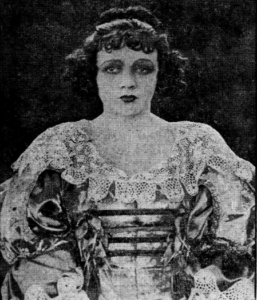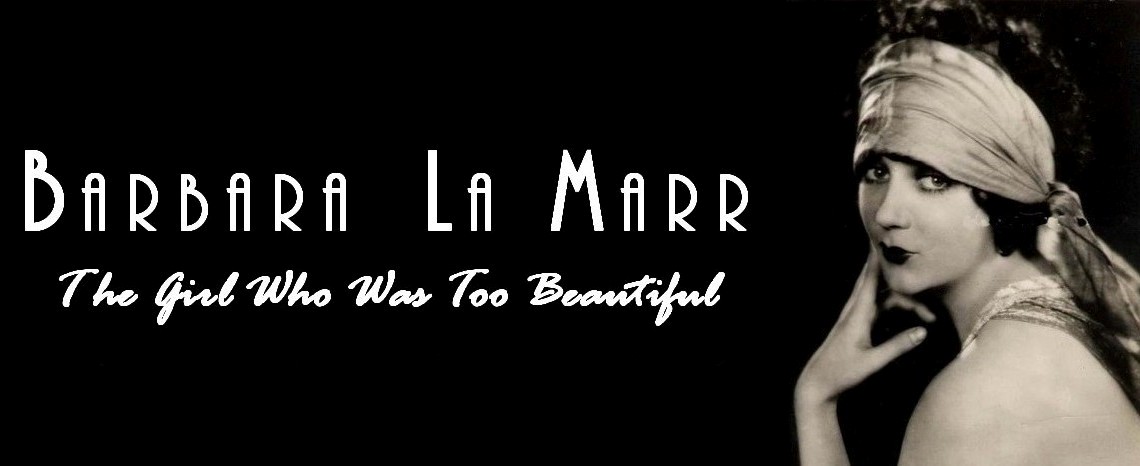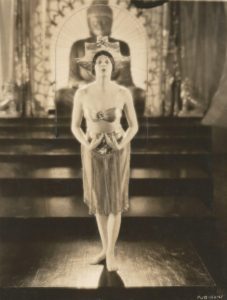Thank you to film journalist and historian Phil Hall for interviewing me about Barbara La Marr and my book, Barbara La Marr: The Girl Who Was Too Beautiful for Hollywood, on his podcast, The Online Movie Show with Phil Hall. I had a great time discussing Barbara’s accomplished careers as a stock theater actress, dancer, vaudevillian, storywriter for the Fox Film Corporation, and silent film actress; her turbulent early years as “the notorious Reatha Watson”; and more. The podcast may be accessed here.
Category Archives: Barbara’s Screenwriting Career
“The Lady That’s Known as Lou”
Barbara is pictured below as she appeared in The Shooting of Dan McGrew (1924), a film said to have been at least partially adapted by her from Robert William Service’s poem of the same name. Barbara portrayed “the lady that’s known as Lou,” a dancer who falls prey to a cunning gambler (Lew Cody) while trying to make a better life for herself, her husband (Percy Marmont), and her son (Philippe De Lacy). Oozing with sex appeal, Barbara’s heated, heartfelt performance was deemed a success by several critics upon the film’s release—though Film Daily warned that her “near-nakedness” would likely prompt scrupulous censors in certain areas to ban the film.
(This photo is among the many in my collection that weren’t included with the seventy-six allowed in my biography, Barbara La Marr: The Girl Who Was Too Beautiful for Hollywood [2017].)
View Barbara in The Three Musketeers (1921)
Those who were unable to attend my performance as Barbara La Marr; the signing of my biography, Barbara La Marr: The Girl Who Was Too Beautiful for Hollywood; and the screening of The Three Musketeers (1921), starring Douglas Fairbanks Sr., Marguerite De La Motte, Nigel De Brulier, Barbara La Marr, and Adolphe Menjou, on March 24 at Hollywood’s Egyptian Theatre may view The Three Musketeers for free online (see link below).
When The Three Musketeers premiered in New York City in August 1921, it was hailed by critics as “a thrilling, gripping, unadulterated success”; “the greatest achievement since the birth of the motion picture industry”; and, “in the words of D’Artagnan”—the film’s gallant hero played by Douglas Fairbanks—“Marvelous.” House records were shattered worldwide as crowds stormed theaters, literally fighting their way to box office windows and necessitating calls for police protection.
The Three Musketeers marked the end of Barbara’s time in the shadows of obscurity as an actress. The thought both exhilarated and frightened her. While still employed as a storywriter at Fox in 1920, Barbara first met Fairbanks on the set of his film The Mark of Zorro, after Marguerite De La Motte—Barbara’s friend and Fairbanks’s leading lady in that film and The Three Musketeers—invited her to accompany her to work one day. Barbara’s beauty, charisma, and talent so impressed Fairbanks that he gave her a small part as a tempestuous gangster’s moll in his film The Nut (1921), then offered her the much-coveted role of the iniquitous spy Milady de Winter in The Three Musketeers, a film that was already anticipated to be an international sensation. Fearful of being recognized as notorious Reatha Watson on the big screen, and the subsequent exposure of her infamous past, Barbara nonetheless accepted the role. She became disheartened, however, when vaudevillian and film actor Ben Deely, her husband at the time, and various others close to her discouraged her from pursuing an acting career, instead advising her to stick with writing. Fairbanks refused to hear of it. When filming for The Three Musketeers concluded, Fairbanks made a prediction. “You are going to be one of the biggest girls on the screen,” he told Barbara. “Wait and see.”
Indeed, critics applauded Barbara’s supporting performance in The Three Musketeers, declaring her “dazzling,” a “fiery” actress, and worthy of stardom. More film offers rolled in for Barbara, and within two years she was an established star. At the height of her fame, she credited the encouragement she received from Fairbanks and director Fred Niblo on the set of The Three Musketeers with preventing her from quitting and fueling her determination to succeed as an actress.
*** Watch Barbara in The Three Musketeers here.

Bridgeport Times and Evening Farmer, November 2, 1921, image of Barbara as Milady de Winter in The Three Musketeers.
(To learn more about the films Barbara wrote and appeared in, visit the Filmography section of this site.)
NOTES:
“a thrilling, gripping, unadulterated success”: “‘Three Musketeers’ Has Greatest Reception Ever Accorded a Film,” Moving Picture World, September 10, 1921, 190.
“the greatest achievement”: “Praise ‘Three Musketeers,'” Motion Picture News, September 17, 1921, 1514.
“in the words of D’Artagnan”: “In the Words of D’Artagnan—Marvelous!!,” Wid’s Daily, September 4, 1921, 2.
“You are going to be one of the biggest”: La Marr, Barbara, “The True Story of My Life,” Movie Weekly, January 24, 1925, pg. 20.
“dazzling”: “Girl of ‘Too Much Beauty’ Wins Fame,” Salt Lake Telegram, October 23, 1921.
“fiery”: untitled photo caption, Picture Play Magazine, March 1922, pg. 42.
Barbara La Marr: Life on Her Own Terms
Classic Movie Hub invited me to contribute a guest blog for their website. In my post, “Barbara La Marr: Life on Her Own Terms,” I discuss Barbara’s commendable talents and her unbending determination to succeed in life, despite myriad obstacles and frequent association with scandal. Read it here.
(There are still opportunities to WIN a copy of my newly released biography, Barbara La Marr: The Girl Who Was Too Beautiful for Hollywood, courtesy of the University Press of Kentucky and Classic Movie Hub! Get the details here.)
Film Synopses Added To Filmography Section
Since I had a window of time between deadlines as my upcoming biography, Barbara La Marr: The Girl Who Was Too Beautiful for Hollywood, nears publication, I compiled and added film synopses for the six films Barbara wrote during her story writing days with the Fox Film Corporation and the twenty-six credited films encompassing her meteoric career as one of the silent screen’s leading actresses. They may be viewed on the Filmography page.
In the future, I’ll be writing more blog posts spotlighting specific films comprising Barbara’s screenwriting and acting careers. Meanwhile, feel free to browse my previous blog posts (see the “Categories” section located on the right—you’ll need to scroll down a bit—and select “Barbara’s Film Acting Career” and “Barbara’s Screenwriting Career” from the drop down menu). I also have many film stills and other photos pertaining to Barbara’s films in the “Galleries” (see the tab at the top). Of course, Barbara’s films are additionally discussed at length in my book, scheduled for release in early December 2017 by the University Press of Kentucky.
More Than a Vamp
At the height of her fame in 1924, Barbara La Marr reportedly earned the modern equivalent of over $30,000 per week as a reigning vamp of the silent screen. Never far from her heart, however, was an inherent compulsion to express herself through the written word. She first put her thoughts to paper as a young girl, composing little verses and short stories. As a young woman, her inner musings took the form of poetry, pouring from her, she said, when she was so consumed with emotion that she just had to have an outlet. Her very first full-length story caught the attention of Winfield Sheehan, general manager of Fox Film Corporation, and won her a contract with Fox in 1920. Fueled by her incredible life experiences, Barbara ultimately penned five original stories and one adaptation for Fox. She put her writing talents to further use crafting intertitles for Fox films and, later, by doctoring scenarios for other studios’ films in which she played starring roles.
All the while, poetry remained her favorite medium of literary expression; to her it was “the freest of the free.” When not before the camera, Barbara sometimes sat on the sidelines of film sets, transcribing her heartfelt feelings into verse and scribbling story ideas. She vowed to one day return to her typewriter, when her career as a film actress had “gone by with the glories.” Sadly, her tragic, untimely death in 1926 at the age of twenty-nine cut short her aspiration.
The six films Barbara wrote for Fox have yet to be located by film preservationists. For now, her writings live on in her poetry. Three of her poems, written before the breakdown that resulted in her death, appear below.
Are You—?
by Barbara La Marr
.
Why should I—who worship Thought—
Unthinkingly bear my Soul unsought,
Dreams that memory cannot dim—
Why should I speak to you of HIM?
.
Why should I tell you all these things—
Of hours when Passion’s wearied wings
Folded beneath a mauve grey sky
Of dawn—that ever means “Good-bye?”
.
Of strange, mysterious, wonderful nights
When I have tasted the gods’ delights;
Of lips I have kissed, and kissing burned—
Of loves I have left and loves returned.
.
When dreaming and close at my side
I felt the urge of Passion’s tide,
I closed my eyes and infinitely sad,
Dreamed of that which I have never had.
.
But why should I—who worship Thought—
Bear my Soul to you unsought—
Telling of dreams Time cannot dim,
Unless—perhaps—that you are him!
*
.
Love and Hate
by Barbara La Marr
.
I love you—
Your lips, your hair, your eyes,
Your willful, reckless, tender lies.
I hate you!
.
I hate you—!
Your smile, your curls, your glance,
You pagan worshipper of Chance…
I love you!
*
.
Moths
by Barbara La Marr
.
Moths?— I hate them!
You ask me “Why?”
Because to me they seem
Like the souls of foolish women
Who have passed on.
Poor illusioned, fluttering things
That find, now as always,
Irresistible the warmth of the
Flame—
Taking no heed of the warning
That merely singed their wings
They flutter nearer–nearer—
Till wholly consumed
To filmy ashes of golden dust.
Foolish—-fluttering—-pitiful things—
Moths! I fear them!
Yet I watch them fascinated
And realize—many things.
Perhaps they are not useless
Nor the message they convey
To me, a futile one.
They make me see the folly
Of seeking that which it seems
Women were created for—
The futility, the uselessness of longing—
Perhaps you do not understand,
But—
Moths!–I hate them!


